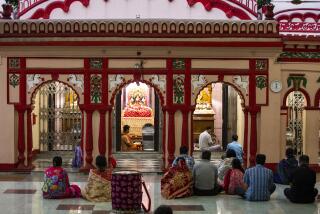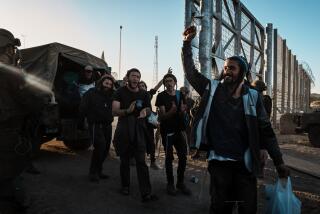Religious Sword Over Pakistan
- Share via
This month in Karachi, Pakistan, at least 14 Shiites were killed and more than 100 were severely wounded while at prayer. Scores more were massacred by Sunni militants in Quetta earlier this year. In the last decade, more than 1,200 people have died in Shiite-Sunni violence. Today, sectarian dispute is Pakistan’s Achilles’ heel, challenging the officially sanctioned “Islamic” state -- and endangering the country’s future.
If Pakistan is to survive, Sunni extremists -- who advocate violent anti-Shiism and an exclusionary form of Islam -- must be brought down. It is not enough for President Pervez Musharraf to seek the capture of foreign jihadists from Al Qaeda and the Taliban. He must aggressively fight homegrown militancy. That’s what it will take to make Pakistan the “liberal, tolerant, progressive, dynamic and strong Islamic state” that Musharraf proposes, and millions of ordinary Pakistanis insist that it can be, rather than a militant’s paradise.
Pakistan’s founder, Mohammed Ali Jinnah, was a Shiite, as were several others who helped him create the new homeland for Muslims. Many Shiites continue to serve and lead Pakistan. They are Islam’s and Pakistan’s largest religious minority, making up about 30 million of the nation’s 148 million people. Yet today they live in escalating terror.
Their crisis is Pakistan’s, emerging from three reinforcing developments. The first is the “Islamization” of laws, army and society begun by President Gen. Zia ul-Haq in the 1980s. The second is the largely unchecked and growing prowess of Sunni extremist groups in their war against Shiites. For them Shiites are “kafirs,” or infidels. The third is the persistent pressure since Pakistan’s creation for ever-purer Islamist politics by the religious political parties, which today are key players in parliament and control the strategic Northwest Frontier Province.
Before Zia put his puritanical religious lens on Pakistani public life, small-scale Shiite-Sunni disturbances flared occasionally but were largely considered law-and-order problems.
In Zia’s time, however, the state itself became a sectarian player, espousing particular Sunni schools of Islamic law. Shiites then organized to resist these laws, which are unacceptable to their traditions. A segment became radicalized, leading to an increase in tit-for-tat violence between Sunnis (supported by Saudi Arabia) and Shiites (supported by Iran).
Today, while extremist Shiites try to retaliate against their enemies, it is mostly ordinary Shiites who die at the hands of groups espousing an anti-Shiite ideology of “kill the infidels.” These same groups are jihadist and pair their deadly pursuit of Shiites with regional and global terror activities. Lashkar-e-Jhangvi, the group suspected in many Shiite massacres, is pro-Taliban, has links to Al Qaeda and is reported to have played a role in the 2002 killing of Wall Street Journal reporter Daniel Pearl. Strategic assaults have been launched across Pakistan against Shiite doctors who ministered in their communities and on Shiite men, women and children inside houses of worship and on busy streets. Prominent Shiites move around with armed bodyguards.
The roots of this crisis of Muslim identity go back even further than Zia’s days, to the 1950s, when the leadership of Pakistan’s most organized, urban religious group, the Jamaat-e-Islami, and other like-minded parties began to use Islam to foster exclusionary politics and public riots by politicizing the question, “Who is a Muslim?”
The Jamaat led a successful movement to have the small Ahmediyya sect -- which is doctrinal anathema to the Jamaat -- declared non-Muslims by the state. In 1974, the then-secular and politically weak Prime Minister Zulfikar Ali Bhutto obliged it with a constitutional amendment. Then, in 1984, Zia made it a criminal offense for Ahmedis to even call themselves Muslims.
With the ouster of the Ahmedis from the fold, the tone was set for progressively more intolerant politics.
Today, a member of parliament can comfortably call a Shiite an infidel. The Sunni extremist Azam Tariq was infamous for his anti-Shiite violence. Yet he could flourish, winning a national assembly seat several times -- most recently in 2000 -- from his jail cell while facing dozens of criminal charges. He became an ally of the pro-Musharraf parliamentary party. Two days before he was assassinated, he told the New York Times -- in his most moderate mien -- that Shiites need not be killed; rather they “should merely be declared non-Muslims and jailed for 10 or 15 years.”
Even as Musharraf bans certain groups and speaks out against sectarian violence, the militants flourish and the number of dead rises. One wants deeds as unflinching as his words. Only if he is able to put a full stop to the kind of Islamization that makes a mockery of an inclusive Muslim homeland; only if he eliminates the sectarian-jihadi complex that feeds off Shiites and other minorities’ lives, only then will Pakistan have a secure future.
If Musharraf fails, then the question, “Who is a Pakistani Muslim?” could destroy all hope for a more progressive and peaceful Pakistan.
Mahnaz Ispahani is a senior fellow for South and West Asia at the Council on Foreign Relations.
More to Read
Sign up for Essential California
The most important California stories and recommendations in your inbox every morning.
You may occasionally receive promotional content from the Los Angeles Times.













